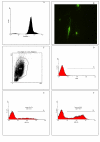A sensitive flow cytometric methodology for studying the binding of L. chagasi to canine peritoneal macrophages
- PMID: 15913461
- PMCID: PMC1166554
- DOI: 10.1186/1471-2334-5-39
A sensitive flow cytometric methodology for studying the binding of L. chagasi to canine peritoneal macrophages
Abstract
Background: The Leishmania promastigote-macrophage interaction occurs through the association of multiple receptors on the biological membrane surfaces. The success of the parasite infection is dramatically dependent on this early interaction in the vertebrate host, which permits or not the development of the disease. In this study we propose a novel methodology using flow cytometry to study this interaction, and compare it with a previously described "in vitro" binding assay.
Methods: To study parasite-macrophage interaction, peritoneal macrophages were obtained from 4 dogs and adjusted to 3 x 10(6) cells/mL. Leishmania (Leishmania) chagasi parasites (stationary-phase) were adjusted to 5 x 10(7) cells/mL. The interaction between CFSE-stained Leishmania chagasi and canine peritoneal macrophages was performed in polypropylene tubes to avoid macrophage adhesion. We carried out assays in the presence or absence of normal serum or in the presence of a final concentration of 5% of C5 deficient (serum from AKR/J mice) mouse serum. Then, the number of infected macrophages was counted in an optical microscope, as well as by flow citometry. Macrophages obtained were stained with anti-CR3 (CD11b/CD18) antibodies and analyzed by flow citometry.
Results: Our results have shown that the interaction between Leishmania and macrophages can be measured by flow cytometry using the fluorescent dye CFSE to identify the Leishmania, and measuring simultaneously the expression of an important integrin involved in this interaction: the CD11b/CD18 (CR3 or Mac-1) beta2 integrin.
Conclusion: Flow cytometry offers rapid, reliable and sensitive measurements of single cell interactions with Leishmania in unstained or phenotypically defined cell populations following staining with one or more fluorochromes.
Figures











Similar articles
-
In vitro binding and survival assays of Leishmania parasites to peripherical blood monocytes and monocyte-derived macrophages isolated from dogs naturally and experimentally infected with Leishmania (Leishmania) chagasi.BMC Vet Res. 2007 May 30;3:11. doi: 10.1186/1746-6148-3-11. BMC Vet Res. 2007. PMID: 17537246 Free PMC article.
-
Histopathological and immunohistochemical study of type 3 complement receptors (CD11b/CD18) in livers and spleens of asymptomatic and symptomatic dogs naturally infected with Leishmania (Leishmania) chagasi.Vet Immunol Immunopathol. 2007 May 15;117(1-2):129-36. doi: 10.1016/j.vetimm.2007.02.012. Epub 2007 Feb 28. Vet Immunol Immunopathol. 2007. PMID: 17383741
-
Serological evaluation of experimentally infected dogs by LicTXNPx-ELISA and amastigote-flow cytometry.Vet Parasitol. 2008 Nov 25;158(1-2):23-30. doi: 10.1016/j.vetpar.2008.09.001. Epub 2008 Sep 6. Vet Parasitol. 2008. PMID: 18848397
-
Receptor-mediated phagocytosis of Leishmania: implications for intracellular survival.Trends Parasitol. 2012 Aug;28(8):335-44. doi: 10.1016/j.pt.2012.05.002. Epub 2012 Jun 21. Trends Parasitol. 2012. PMID: 22726697 Free PMC article. Review.
-
Leishmania and the macrophage: a marriage of inconvenience.Immunol Today. 1989 Oct;10(10):328-33. doi: 10.1016/0167-5699(89)90188-6. Immunol Today. 1989. PMID: 2679629 Review.
Cited by
-
Toll receptors type-2 and CR3 expression of canine monocytes and its correlation with immunohistochemistry and xenodiagnosis in visceral leishmaniasis.PLoS One. 2011;6(11):e27679. doi: 10.1371/journal.pone.0027679. Epub 2011 Nov 30. PLoS One. 2011. PMID: 22140456 Free PMC article.
-
Epigenetic paradigms/exemplars of the macrophage: inflammasome axis in Leishmaniasis.Mol Cell Biochem. 2022 Nov;477(11):2553-2565. doi: 10.1007/s11010-022-04460-x. Epub 2022 May 20. Mol Cell Biochem. 2022. PMID: 35595955 Review.
-
In vitro Infectivity of Strains Isolated From Dogs Naturally Infected With Leishmania infantum Present a Distinct Pathogenic Profile in Hamsters.Front Med (Lausanne). 2020 Aug 28;7:496. doi: 10.3389/fmed.2020.00496. eCollection 2020. Front Med (Lausanne). 2020. PMID: 32984376 Free PMC article.
-
Leishmania amazonensis-Induced cAMP Triggered by Adenosine A2B Receptor Is Important to Inhibit Dendritic Cell Activation and Evade Immune Response in Infected Mice.Front Immunol. 2017 Jul 25;8:849. doi: 10.3389/fimmu.2017.00849. eCollection 2017. Front Immunol. 2017. PMID: 28791011 Free PMC article.
-
In vitro binding and survival assays of Leishmania parasites to peripherical blood monocytes and monocyte-derived macrophages isolated from dogs naturally and experimentally infected with Leishmania (Leishmania) chagasi.BMC Vet Res. 2007 May 30;3:11. doi: 10.1186/1746-6148-3-11. BMC Vet Res. 2007. PMID: 17537246 Free PMC article.
References
Publication types
MeSH terms
Substances
LinkOut - more resources
Full Text Sources
Research Materials
Miscellaneous

